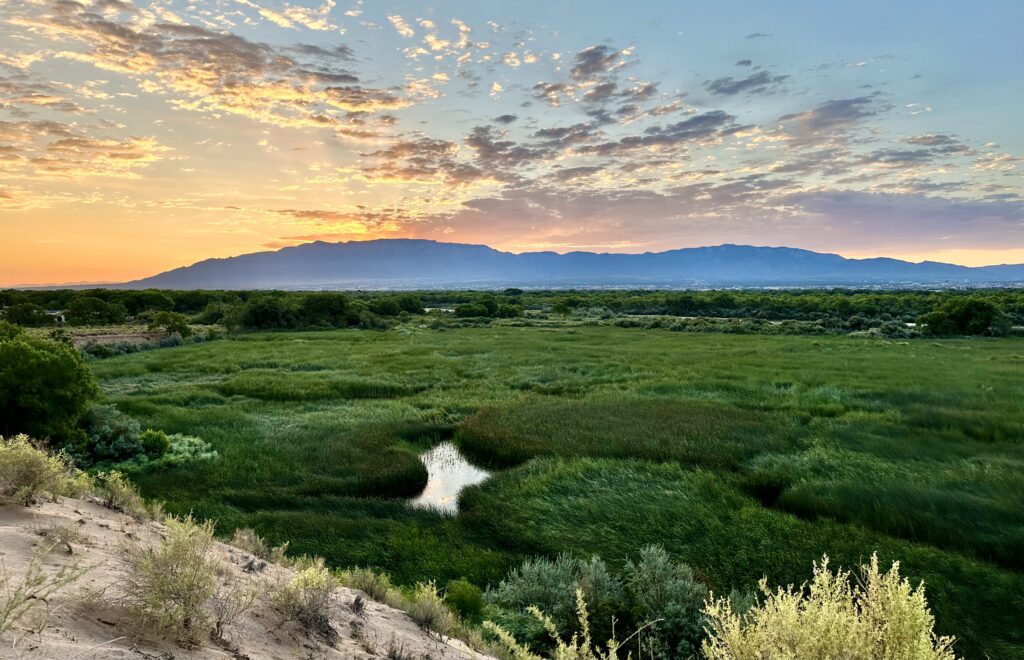
Wetlands play important roles in water management and ecology; they provide unique habitats, slow water movement along rivers in times of flooding, decrease erosion by stabilizing stream beds, improve the quality of water which moves through them, and recharge groundwater. Although much of New Mexico is arid, our state does have wetlands (look for them on the National Wetlands Inventory map!). Our wetlands are increasingly endangered.
A wetland is broadly defined as an area with plants and water. The four general classifications of wetlands are: 1) Marshes – areas which have continual, mostly surface, water and soft stemmed vegetation; 2) Swamps – areas often found alongside sluggish rivers and which have more shrubs and woody plants; 3) Bogs – spongy areas which may have moss and get their water from rain which saturates the soil; and 4) Fens – water-logged areas which can get their water from either surface or groundwater and can form peat over years.
In New Mexico, Amigos Bravos has done a lot of work in wetland protection and restoration in the Taos area. Their Wetlands Jewel Project has an informative website with many photos of 22 different sites (for example, Midnight Meadows and La Jara Canyon) which they have identified for protection or restoration in the Carson and Santa Fe National Forests. This work requires much cooperation from ranchers, BLM, Forest Service, county and municipal zoning, and others, as the wetlands can cover a vast area and be subject to many conflicting interests and jurisdictions.
Rio Grande Return is another organization working in wetland restoration. Their riverscape restoration along the San Antonio Creek is a good example of using Beaver Mimicry to increase wetlands. They have built 40 dams on a stretch of the creek. In the past four years, the water table has risen an impressive three feet.
In Bernalillo County, there is a 60–80 acre wetland called the San Antonio Oxbox on the west side of the Rio Grande. It can be reached by taking Namaste NW off of Coors NW. From the parking lot there are two trails: one provides views along the rim and the other descends and crosses some arroyos. Neither are marked as this property is still being developed by the City of Albuquerque’s Open Space division. Wildlife you might see, especially in early morning, include beaver, muskrat, deer, coyote, porcupine, bobcat, and fox. On the east side of the river, connected wetland ponds have beaver living in them in the Tingley Beach area. Both Valle del Oro and The Nature Center have plans to re-establish wetlands, and members of the Isleta Pueblo have been working for the past two years to clean out invasive species in their 1,000 acre bosque to reconnect the river to its flood plain.
A complex urban project managed by The Nature Conservancy, with collaboration from eight other advocacy groups and governmental agencies, is the Harvey Jones Channel. This is an example of what is called green stormwater infrastructure, a process for managing stormwater. It begins in the 60-square mile Montoya Watershed above Corrales and moves the stormwater through Corrales to the Rio Grande through the Harvey Jones Channel. The Harvey Jones Channel is joined towards the end by treated wastewater from Rio Rancho, allowing for year-round water. It acts as a bioswale, which is a linear U-shaped ditch with high sides that allows water to collect, penetrate into groundwater and, eventually in this case to the Rio Grande. The final part of the bioswale channel is a 10-acre parcel which curves in order to slow the speed of the water. Vegetation planted along its sides includes thousands of willow stems and cottonwood poles. This new wetland functions to additionally clean water and provide habitat for birds and other animals along the river.
In Socorro County, the Ladd S. Gordon Waterfowl Complex in Bernardo and the Bosque del Apache National Wildlife Refuge are examples of marsh wetlands, both increasing the water table height and providing habitat for migrating birds and other wildlife year-round.
New Mexico is not full of wetlands, but the ones we have are important and need our protection. Some need restoration, and the Harvey Jones Channel and its wetlands project demonstrate how green stormwater infrastructure can solve problems while creating a wetland with all its environmentally positive outcomes.

